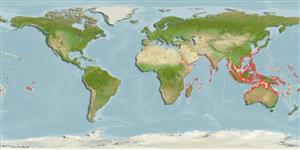Common names from other countries
Issue
The species in the genera Spratelloides Bleeker, 1851 and Jenkinsia Jordan & Evermann, 1896 should most probably be assigned to a separated family from Clupeidae and Dussumieriidae (Lavoué, pers. comm., July 2013). See a preliminary analysis in Lavoué et al. (2013: Ref. 93878).
Environment: milieu / climate zone / depth range / distribution range
Οικολογία
Θαλασσινό(ά); εύρος βάθους ? - 40 m (Ref. 86942). Tropical; 33°N - 30°S, 33°E - 136°W (Ref. 188)
Indo-Pacific, from Red Sea south to Tanzania and east to Samoa (excluding the Cook, Society and Marquesas islands) and the Tuamoto Islands, north to southern Japan and south to western Australia and Kermadec Islands.
Length at first maturity / Μέγεθος / Βάρος / Age
Maturity: Lm ?, range 4 - ? cm
Max length : 10.5 cm SL αρσενικό/απροσδιόριστο; (Ref. 54980)
Ραχιαίες άκανθες (συνολικά) : 0; Μαλακές ραχιαίες ακτίνες (συνολικά) : 12 - 13; Εδρικές άκανθες: 0; Μαλακές εδρικές ακτίνες: 12 - 13. Maxilla toothed, triangular pre-maxillae, 2 supra-maxillae, second supra-maxilla asymmetrical (lower part larger than upper part), vertical striae on scales not meeting at center; W-shaped pelvic scute; few branchiostegal rays (6 or 7).
Usually an inshore schooling species, inhabiting relatively clear waters of coastal, lagoon, and seaward reefs (Ref. 11230). Relative fecundity is 1596 eggs per unit body weight (Ref. 4383). Caught with beach seines, purse seines, ringnets and dipnets. Marketed fresh or dried-salted (Ref. 5213). Used as bait in the tuna fishery.
Whitehead, P.J.P., 1985. FAO Species Catalogue. Vol. 7. Clupeoid fishes of the world (suborder Clupeoidei). An annotated and illustrated catalogue of the herrings, sardines, pilchards, sprats, shads, anchovies and wolf-herrings. FAO Fish. Synop. 125(7/1):1-303. Rome: FAO. (Ref. 188)
IUCN Red List Status (Ref. 130435)
CITES (Ref. 128078)
Not Evaluated
Threat to humans
Harmless
Human uses
αλιεία: περιορισμένης εμπορικότητας; δόλωμα: usually
Εργαλεία
Special reports
Download XML
Διαδικτυακές πηγές
Estimates based on models
Phylogenetic diversity index (Ref.
82804): PD
50 = 0.5625 [Uniqueness, from 0.5 = low to 2.0 = high].
Bayesian length-weight: a=0.00513 (0.00321 - 0.00820), b=3.11 (2.97 - 3.25), in cm Total Length, based on LWR estimates for this species & (Sub)family-body (Ref.
93245).
Τροφικό Επίπεδο (Ref.
69278): 3.1 ±0.0 se; based on diet studies.
Ελαστικότητα (Ref.
120179): Υψηλό, ελάχιστος χρόνος για διπλασιασμό πληθυσμού < 15 μήνες (K=0.41-0.44; tm<1; Fec=505).
Prior r = 1.19, 95% CL = 0.78 - 1.78, Based on 1 data-limited stock assessment.
Fishing Vulnerability (Ref.
59153): Low vulnerability (10 of 100).
Climate Vulnerability (Ref.
125649): High vulnerability (62 of 100).
